During sexual reproduction, new combinations of genes are constantly created, which increases the genetic diversity of the offspring and, accordingly, the chances of adapting to changing environmental conditions. The creation of new gene combinations occurs during the process of meiosis. Meiosis occurs during the formation of haploid cells - spores or gametes. In this case, the chromosomes inherited by the body from the mother and father cease to exist as a whole - as a result of crossing over, new variants of chromosomes are formed, combined from the paternal and maternal ones. Thus, the chromosomes of children, as a rule, are not identical to the chromosomes of their parents - they contain different combinations of alleles (gene variants).
During meiosis, a reduction of the chromosome set occurs - the formation of 4 haploid cells (n) from a diploid cell, in which each chromosome is no longer represented by a pair of homologues, but by 1 chromosome. In humans, sex cells (gametes) are formed through meiosis, each of them carries 23 chromosomes.
Diploidy of cells in life cycle is restored during fertilization - the fusion of gametes. In this case, two different chromosome sets from two different genomes (the mother's genome and the father's genome) are combined.
In other organisms, the ratio of diploid and haploid phases of the cycle may be different. Different organisms exhibit a wide variety of life cycles, but in all of them it is possible to distinguish diploid phase, or diplophase- from fertilization to meiosis - and haploid phase, or haplophase- from meiosis to the next fertilization.
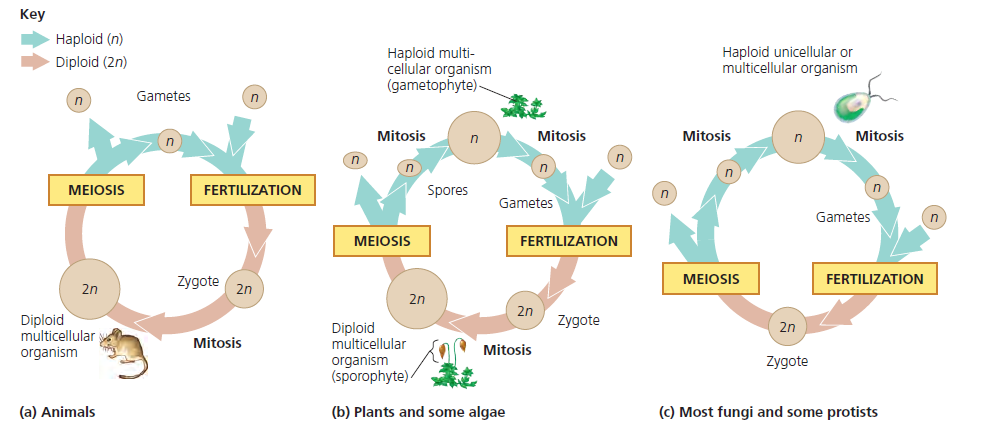
For example, in animals (left) only gametes are haploid, in plants (middle) there is a diploid generation (sporophyte) and a haploid generation (gametophyte), and in many unicellular organisms the haploid phase predominates, and the zygote after fertilization divides by meiosis, resulting again in haploid cells.
The ratio of haploid and diploid stages in the life cycle different organisms may be different. As we have already seen, in animals the only stage is diploid, and only gametes are haploid. In some organisms, on the contrary, the only stage is haploid, and only the zygote is diploid, which immediately after the sexual process enters meiosis. We can observe this situation, for example, in Chlamydomonas. Most plants have both phases. In mosses, the green plants we are familiar with are haploid. The organs of sexual reproduction are formed on them: antheridia, in which sperm are formed, and archegonia, each of which contains one egg. The resulting gametes after fertilization give rise to a diploid stage, which develops directly from the haploid stage. It is a thin long thread with an extension at the end. It is brown in color because it does not contain chlorophyll, is incapable of photosynthesis and lives off the haploid part of the plant. Inside an extension called a capsule, many cells divide by meiosis to form haploid spores. Spores give rise to green haploid plants. Thus, the main stage in mosses is haploid.
The main life stage of ferns is diploid. Sporangia are formed on the leaves of ferns or in special structures of horsetails and clubmosses, in which small unicellular spores are formed as a result of meiosis. Scattering and finding suitable conditions, they give rise to the haploid stage - the outgrowth. Antheridia and archegonia form on the shoots, gametes are formed, fertilization occurs, and a diploid plant develops from the zygote. In seed plants, there is no independent haploid stage; it is represented by groups of cells developing in special organs of diploid parent organisms. For some time, only the male gametophyte exists separately in the form of a pollen grain, but at this time no noticeable vital processes occur in it. After fertilization from the zygote, the new diploid organism also undergoes the first stages of development inside the mother’s body.
Systematic position
Kingdom: plants
Higher spore plants
Superdivision: bryophytes
Division: bryophytes, or true mosses
Class: phyllophytic, or true, mosses
Class: sphagnum mosses
Department: liver mosses
Department: anthocerote mosses
Bryology- science of bryophytes.
Main characteristics of the Bryophyte department
- Small sizes.
- Wet habitats.
- No roots, only rhizoids.
- No conductive fabric.
- For sexual reproduction, the presence of droplet-liquid moisture is necessary for the movement of sperm.
- In the life cycle there is an alternation of generations with a predominance of the haploid gametophyte (!).
Department Bryophytes
CLASS LEAF MOSSES
Kukushkin flax (Fig. 1)
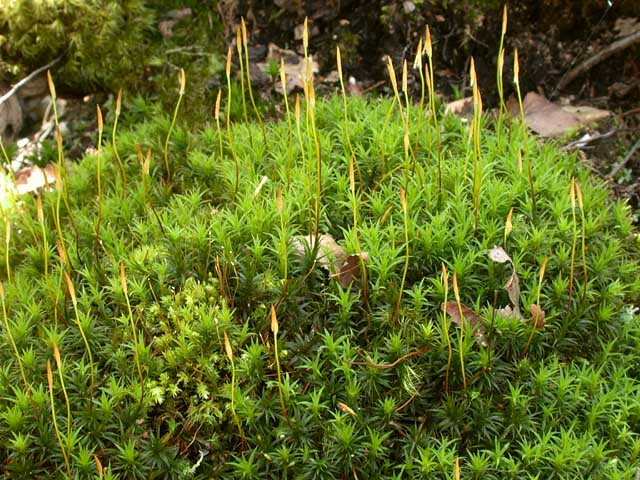
Widely distributed in moist forests of the temperate zone. Its brownish stem, reaching a length of 30 cm, contains dead elongated cells, performing the function of conducting and accumulating water. Simple leaves consist of several layers of green cells and have no veins. In the lower part of the stem of young moss, single-celled outgrowths are formed - rhizoids, which perform the function of absorbing water and mineral salts. Typically, cuckoo flax grows in the form of clumps containing several hundred individuals. Green moss plants are the haploid stage, or gametophyte. Cuckoo flax moss is a dioecious, or dioecious, plant. At the top of some plants, female organs, called archegonia (Fig. 2).
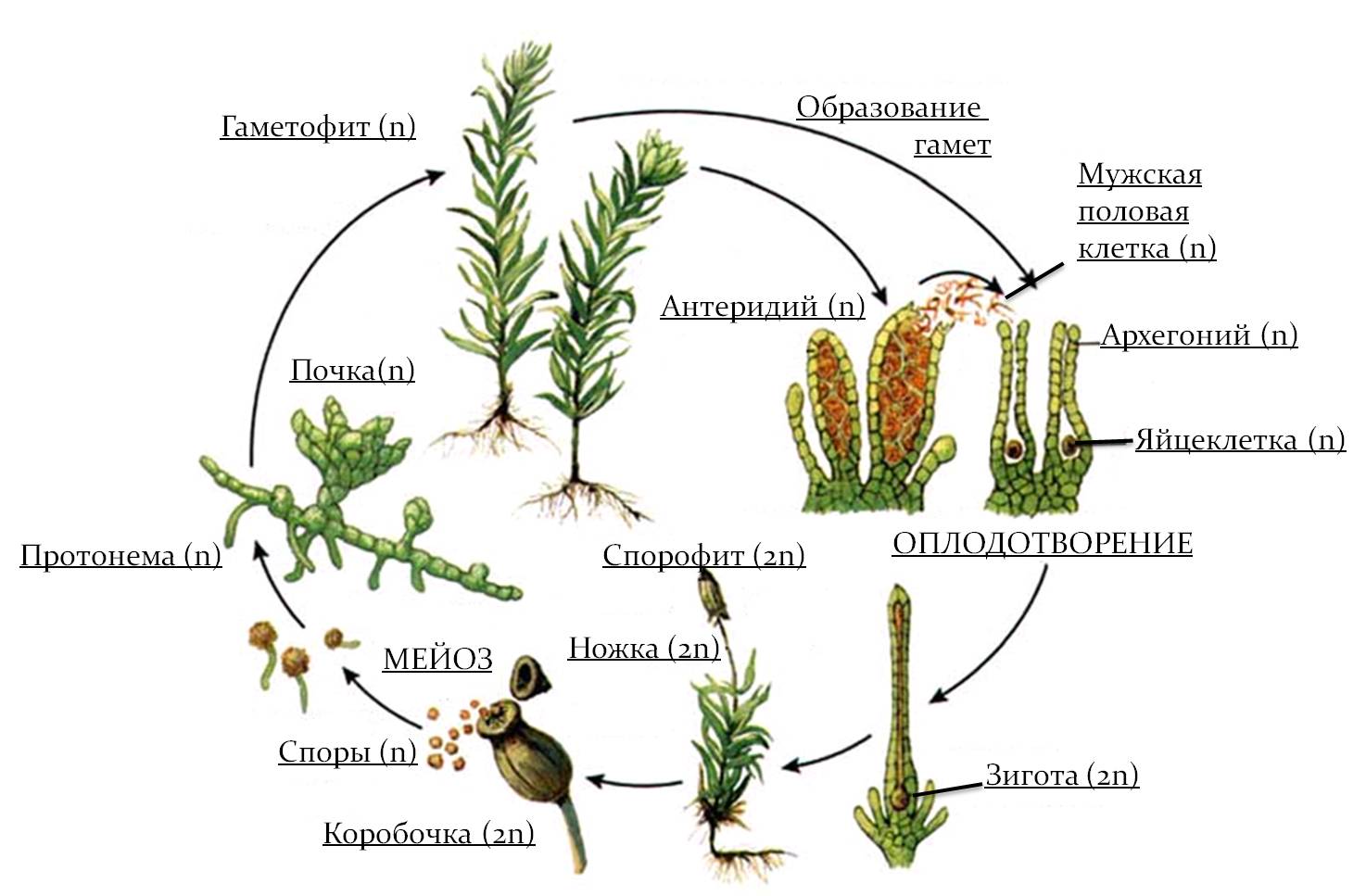
Each archegonium contains one egg. On male plants antheridia develop - organs that are sacs in which sperm are formed. Since the plant is haploid, the formation of gametes does not require meiosis. For fertilization, moss needs water through which sperm can swim. female plant and penetrate the archegonium. For this, rain or heavy dew is enough, drops of which will fall on the tops of the plants. After fertilization, a diploid sporophyte develops from the resulting zygote. It grows on a haploid green plant and uses the substances it produces. It itself does not contain chlorophyll and does not photosynthesize. It looks like a long brown thread called a stalk. At one end it is attached to the top of the gametophyte, and at the other an extension is formed, which is the sporangium. In this expansion, spore mother cells are formed, which divide by meiosis to form many single-celled spores. A mature sporangium consists of a capsule and a cap. The lid comes off and the spores spill out and are carried by the wind over long distances. A thin branching thread grows from spores caught in a moist, illuminated place. (protonema). At its ends, buds form, giving rise to new haploid plants.
CLASS SPAGNUM MOSSES
Sphagnum moss
An important group of mosses are sphagnum mosses (Fig. 3). They are widespread and form so-called sphagnum, or raised, bogs. The tops of sphagnum moss have light green leaves. As the moss grows, its lower part ends up under a layer of younger leaves, dies and begins to decompose. Moss tissue contains carbolic acid, which has a powerful bactericidal effect. Moss decomposition occurs without air access and in almost complete absence microorganisms. Moss practically does not rot and turns into peat. Peat, like a sponge, retains moisture, causing forests to become waterlogged.
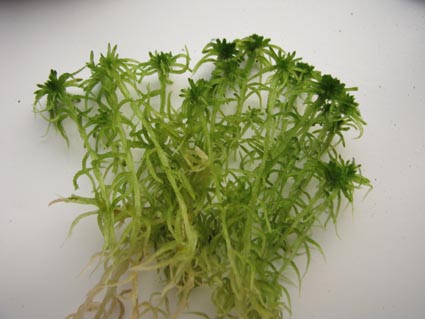
Sphagnum does not have rhizoids. It absorbs water over its entire surface. The small light green leaves covering the stem and branches are composed of two types of cells that are clearly visible under a microscope. Narrow green photosynthetic cells form a network structure in which movement occurs organic matter. Between them there are large transparent dead cells, of which only the membranes remain (Fig. 4). These cells serve as a reservoir for water. Through the pores in them cell walls water supplies are replenished from the surrounding air.

Sphagnum is a monoecious plant. Archegonia (female reproductive organs) and antheridia ( male organs sexual reproduction) are located on one plant. Spermatozoa (n) drop by drop of water reach the eggs (n), fertilization occurs. A zygote (2n) is formed, from which a sporangium grows. Meiosis occurs there and haploid (n) spores are formed, giving rise to a thin pre-teen thread - protoneme (n). A bud forms on it, growing into a new gametophyte (n).
ORDER LIVER MOSSES
Small tender plants, the body of which is most often represented by a thallus in the form of a plate irregular shape. In some, the thallus bears scales corresponding to the leaves. There are numerous rhizoids. The protonema is poorly developed.
Reproduction is sexual (like other mosses) and asexual (using special buds).
A common representative of liver mosses is Marchantia (Fig. 5).

Rice. 5
ORDER ANTHOCEROTATE MOSSES (FIG. 6)
Lamellar thallus.
Distributed for the most part in the tropics.
Sporophytes ( sporogony) horn-shaped.
At the base of the sporangium stalk there is a meristem, so the stalk is constantly growing. The formation and maturation of spores takes a long time.
Most are monoecious. Cross pollination (female and male gametophytes mature in different time).
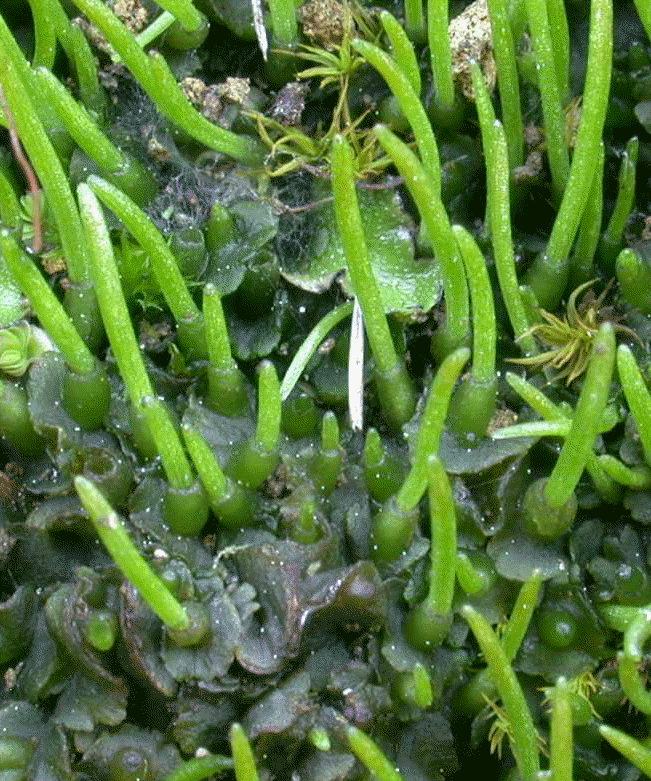
The meaning of mosses
- Peat formation.
- Water reserves of ecosystems.
- Species forming ecosystems.
- Contains antibiotics.
Systematic position
Kingdom: plants
Higher spore plants
Superdivision: pteridophytes
Division: ferns
Division: lycophytes
Division: horsetail
General characteristics of ferns
- Originated in the Devonian. They reached their biological peak in the Carboniferous, becoming the main forest-forming group. The remains of forests formed vast deposits of coal.
- The largest number of species is in the tropical zone.
- They prefer wet habitats, because... male gametes are mobile, and moisture is needed to move the sperm to the egg.
- There are tissues and organs.
- The life cycle is dominated by the diploid sporophyte.
- Reproduction is sexual and asexual (sporulation).
- The organs of sexual reproduction are multicellular.
Division Ferns
The department currently contains approximately 12,000 species.
Life forms: grasses, trees (Fig. 1) and vines (several tropical species). There are aquatic forms (salvinia floating (Fig. 2)).
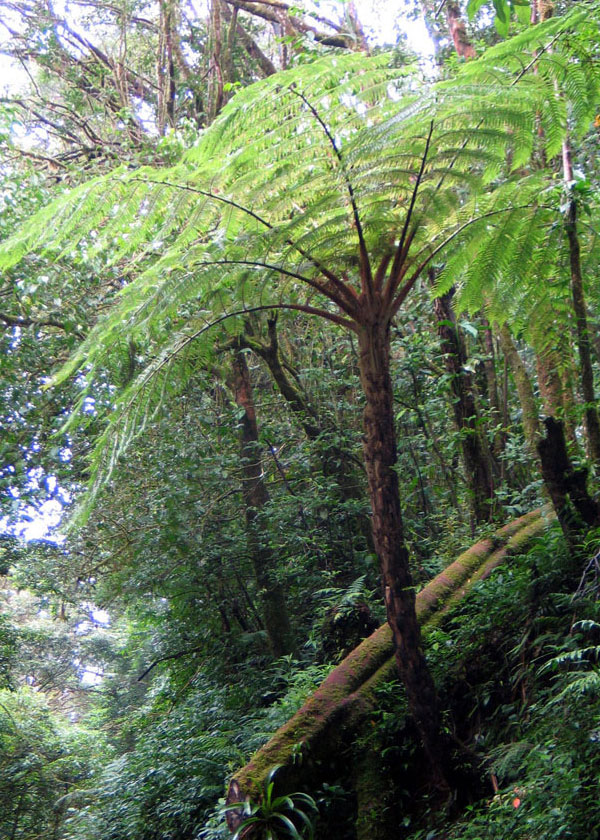
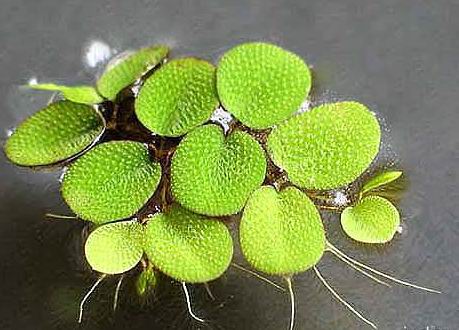
Rice. 1 Fig. 2
Fern leaves - fronds- solid or complexly dissected with a well-developed conducting system. Leaf development occurs from the “snail” (Fig. 3).
Leaves can be differentiated into sterile and fertile (ferns (Fig. 4)), or perform both functions simultaneously (most ferns (Fig. 5)). In ostrich, fertile leaves do not photosynthesize (Fig. 6).

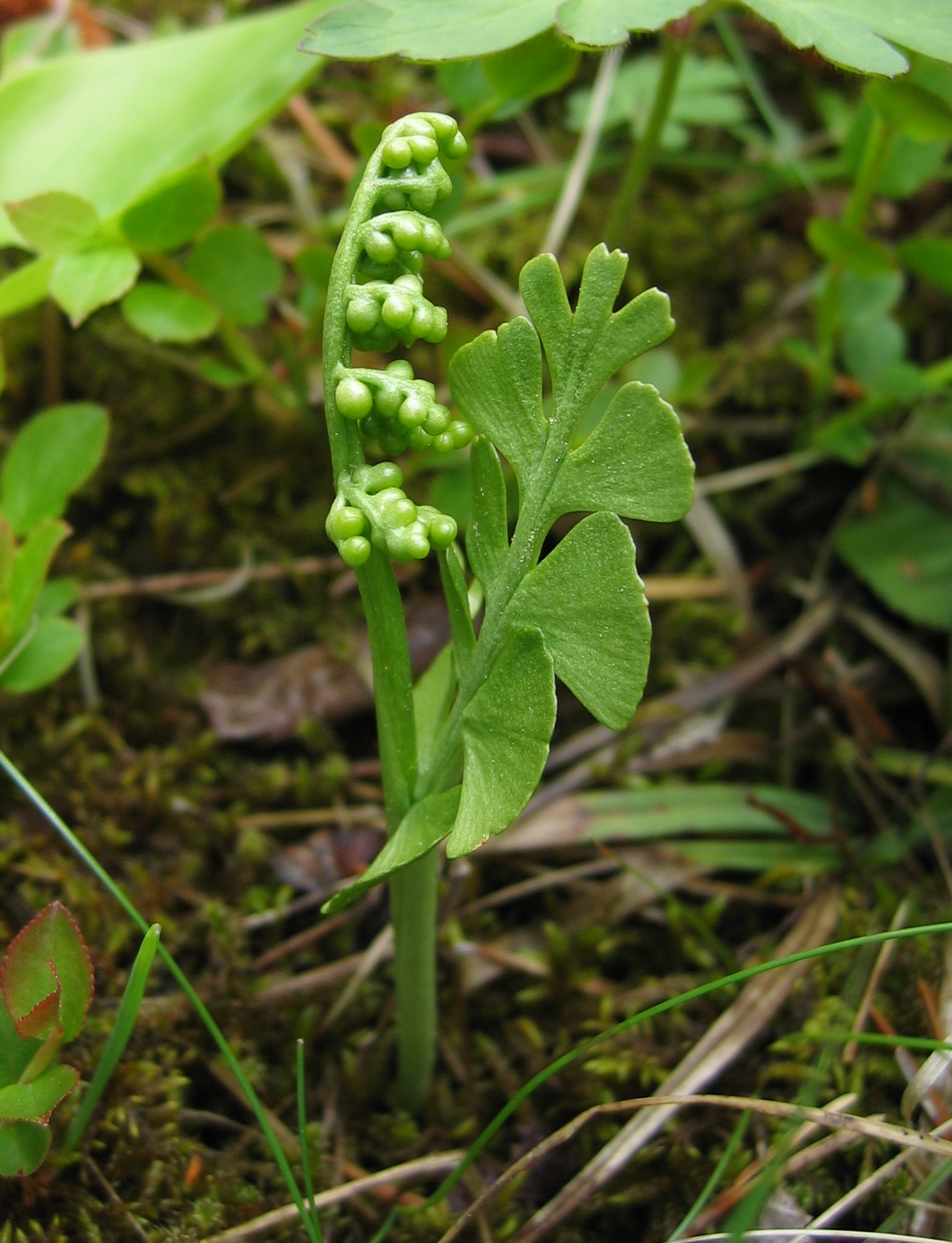
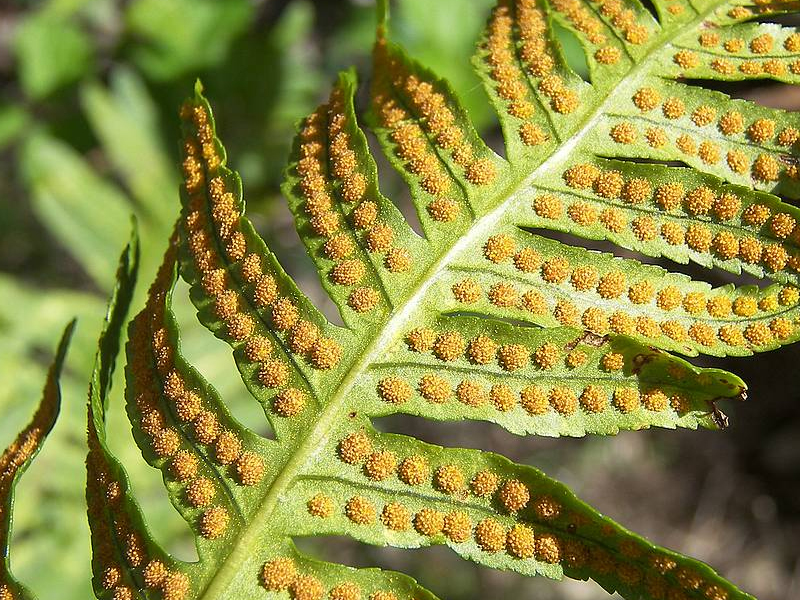
Rice. 3 Fig. 4 Fig. 5
Most ferns have an underground rhizome and well-developed adventitious roots (Fig. 7).
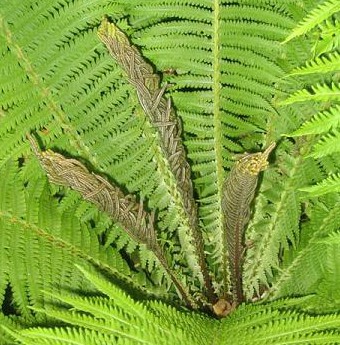
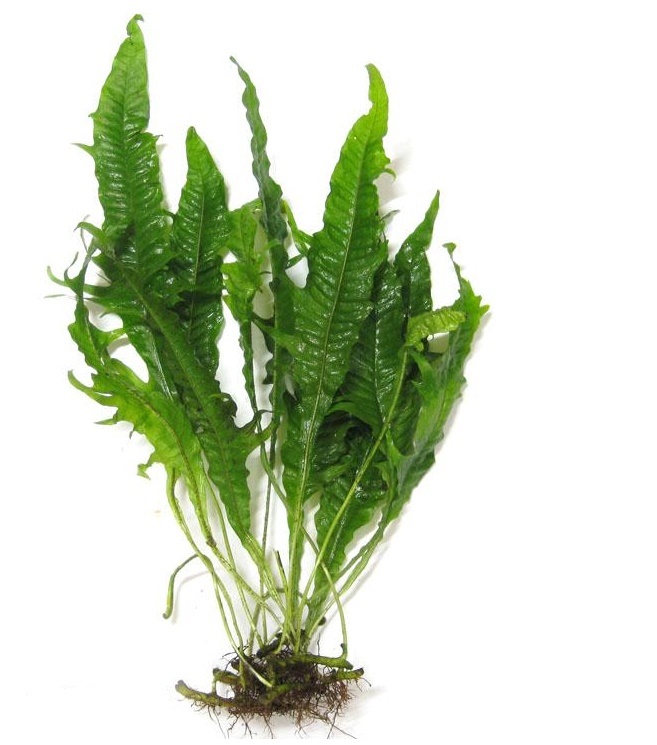
Rice. 6 Fig. 7
The life cycle of ferns involves an alternation of haploid gametophyte and diploid sporophyte, with sporophyte predominance. In the life cycle there is an alternation of sexual and asexual reproduction(Fig. 8).
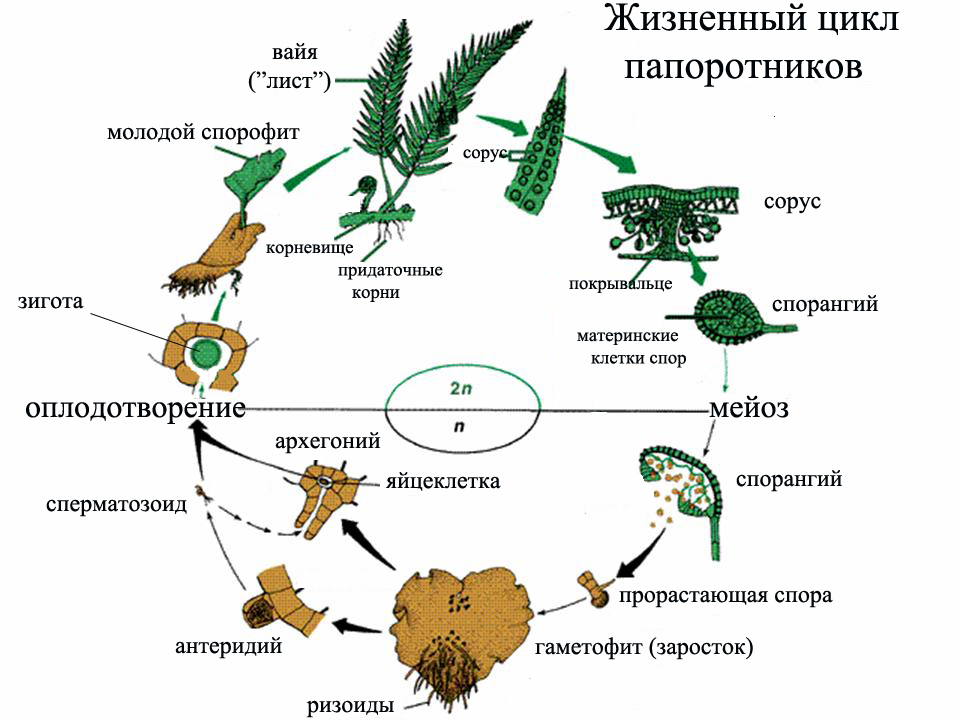
During asexual reproduction, paired outgrowths are formed on the underside of the leaf - sori(Fig. 9). The sorus consists of a stalk and a veil covering the spherical sporangia from below (Fig. 10) extending from the base of the stalk. The sporangia form spore mother cells, which divide by meiosis to form haploid cells that become spores. In dry weather, the edges of the veil bend, and the sporangium shell bursts due to uneven thickening of the walls of the cells that form it.
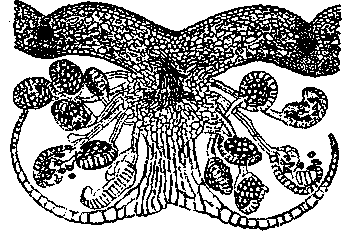

Rice. 9 Fig. 10
From spores that fall into a moist, illuminated place, a haploid fern gametophyte develops - outgrowth- in the form of a heart-shaped plate with numerous rhizoids. On its lower side, antheridia with sperm and archegonia with eggs are formed. Just like mosses, ferns need water to fertilize. Along it, multiflagellate spermatozoa of the fern swim to the archegonia. There, the sperm fuses with the egg to form a diploid zygote. A new diploid plant grows from it.
In the forests of the temperate zone, the most common species are male shieldweed, female stumpweed, and bracken.
Section lycophytes
- The shoot is creeping, dichotomously branching.
- Leaflets (phylloids)small, simple, with one central vein.
- Reproduction is sexual and asexual (sporulation).
- The life cycle is dominated by the diploid sporophyte.
A representative of the club mosses that are often found in our country is the club moss (Fig. 11).
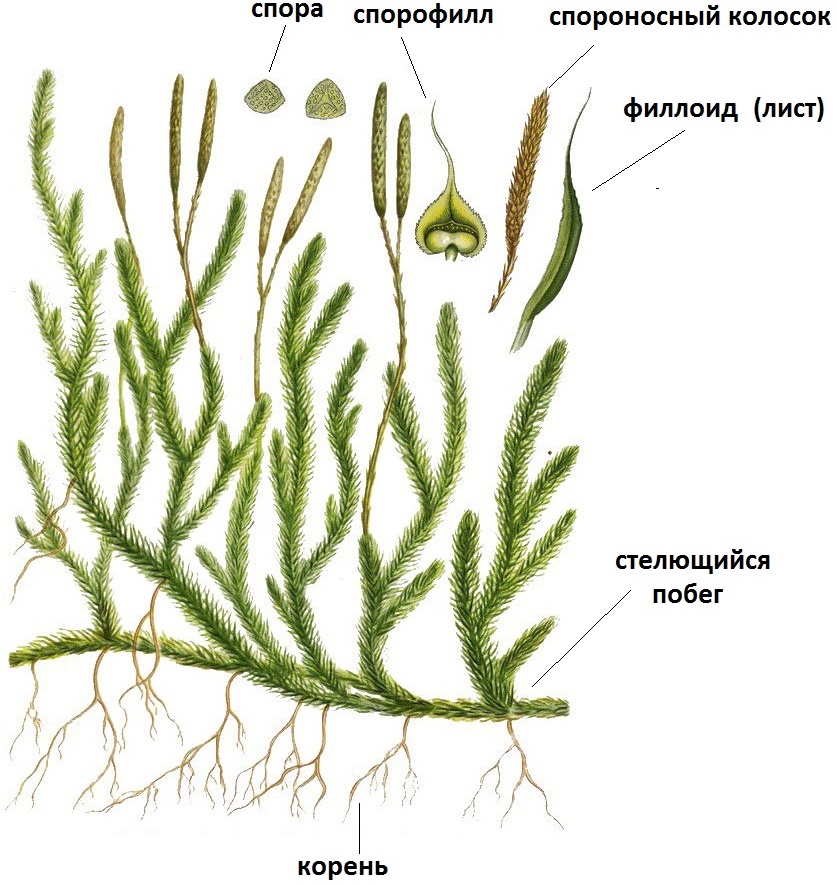
In the life cycle of mosses, like all pteridophytes, there is an alternation of sexual and asexual reproduction (Fig. 12). At the ends of the shoots of the moss, erect spore-bearing spikelets- strobes. Spore-bearing spikelets are covered with modified scale-like leaves - sporophylls- on which sporangia are formed. In sporangia, haploid spores are formed as a result of meiosis. Ripe spores spill out, and a haploid prothallus develops from them. In many species of club mosses, the growth develops underground for several years, feeding heterotrophically, mainly due to symbiosis with the fungus. On a mature gametophyte, archegonia with eggs and antheridia with sperm are formed. After fertilization, the zygote develops into a diploid sporophyte, which feeds on the gametophyte until it reaches the surface of the earth, where it begins to photosynthesize.
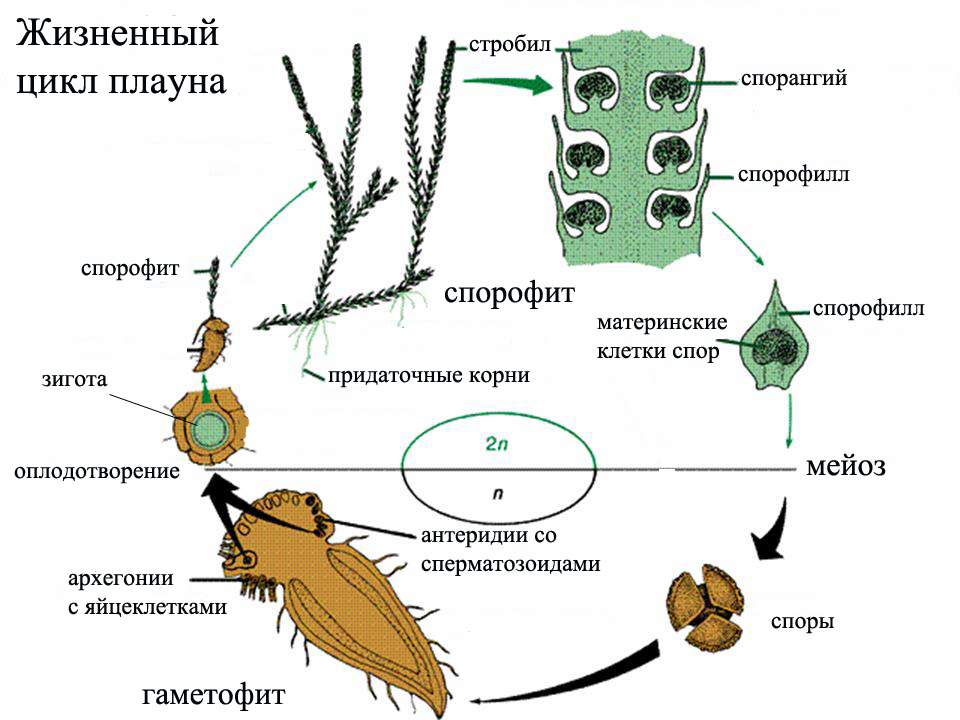
Division Equisetae
An ancient group of vascular plants, currently represented by approximately 30 species.
The stems are hollow, consisting of individual segments and performing the function of photosynthesis (Fig. 13). To increase strength, bundles of sclerenchyma fibers pass under the epidermis, forming ribs on the surface of the stem. In addition, small crystals of silicon oxide are deposited in the stems of horsetails, increasing their rigidity.
Under the ground, horsetail forms a dense network of rhizomes that serve for vegetative propagation and survival through winter.
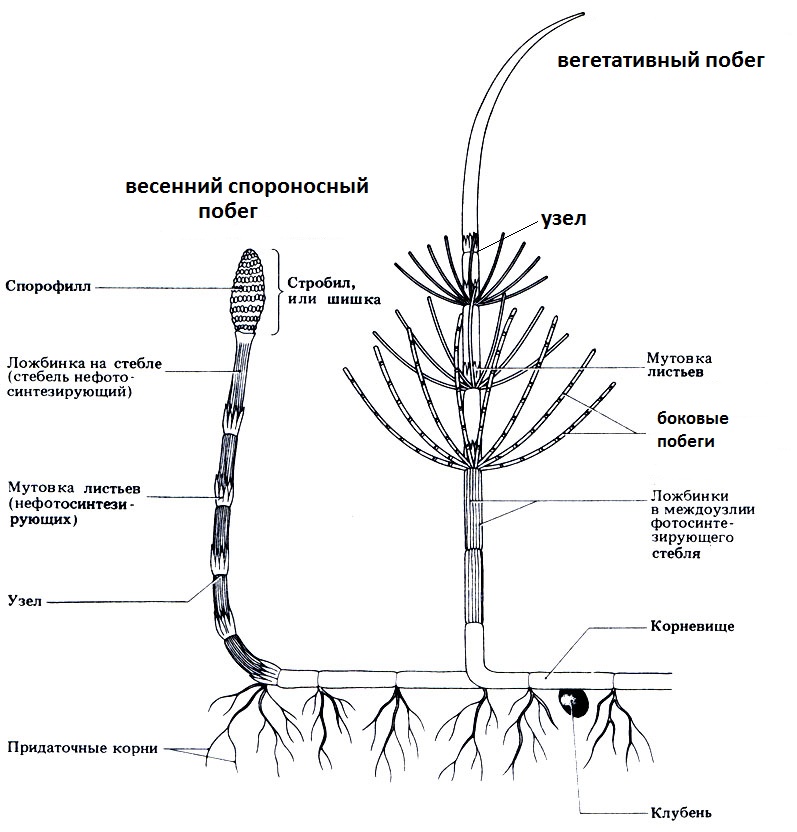
In spring, spore-bearing shoots emerge from the ground. They have Brown color, because they do not contain chlorophyll and live off the reserves accumulated last year nutrients. On their sporophylls, as a result of meiosis, haploid spores are formed, which have special thread-like outgrowths that change shape depending on humidity. This allows them to leave the sporangium more easily and spread more widely. They give rise to a haploid germ. The life cycle of horsetails is similar to the life cycle of ferns (Fig. 14).
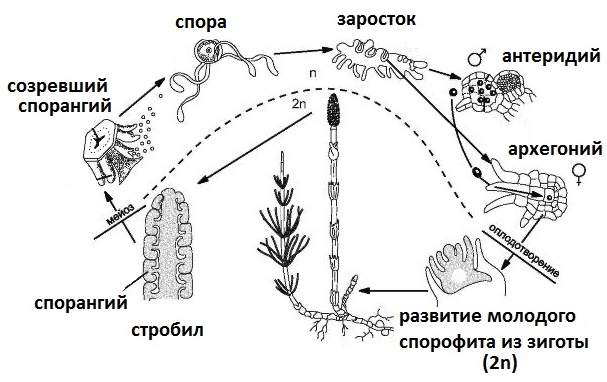
Reproduction of spore plants.
Raunique reproductionproperty of any living organism. Reproduction on your own biological significance differs significantly from all other vital functions of the body. Reproduction increases the number of new organisms similar in appearancenykh with maternal. Thanks to reproduction, there are more individuals of any species. In nature, there are 2 forms of reproduction. Sexual and asexual.During sexual reproduction, haploid gametes are formed as a result of meiosis. At the moment of fertilization, a diploid zygote is formed due to the fusion of two haploid cells. Multiple mitotic divisions the zygote and its descendants lead to an increase in the number of diploid cells that build the body of the organism during its development. Upon reaching puberty, the process of formation of haploid gametes resumes.Plants have excellent property from other organisms, they alternate generations during sexual reproduction.Thus, in the life cycles of organisms that reproduce sexually, two phases are distinguished:haploid and diploid (Fig. 5.11). The relative duration of these phases varies among representatives various groups living beings: in protozoa and fungi the first predominates, in higher plants and animals - the second.In the evolution of plants, there was a transition from haploidy to diploidy.The lengthening of the diplophase during evolution is explained by the advantages of the diploid state over the haploid state. Due to heterozygosity and recessivity in the diploid state, they are protected from natural selection, various alleles are preserved and accumulated. This increases the volume of genetic information in the gene pools of populations and species, leading to the formation of a reserve of hereditary variability, on which evolutionary prospects depend. At the same time, in heterozygotes, harmful recessive alleles, without affecting the development of the phenotype, do not reduce viability.
Terminology
Sporophyte- a diploid multicellular phase in the life cycle of plants and algae, developing from a fertilized egg or zygote and producing spores. Develops from a fertilized egg, or zygote.
Meiosis – reduction division eukaryotic cells, at
in which the number of chromosomes in the nucleus is halved.
Spores (n) are non-sexual haploid cells, using
which asexually plants and fungi reproduce.A spore is usually a single-celled formation that serves for asexual reproduction and is capable of developing into an adult, i.e. independent organisms can develop from spores without merging with each other
All plants produce spores in one form or another. The process of their formation is called , and the cell or organ in which they are formed carriesName
Very often, spores are surrounded by a special shell and can tolerate unfavourable conditions, such as winter or dry periods. Since the spores are very light, they are freely carried through the air by wind or other agents and serve to disperse plants. Spores germinate immediately when moisture enters the cell
Mitosis is a method of dividing eukaryotic cells, resulting in
which produces two cells with exactly the same set
chromosomes, like the mother's.
Gametophyte (n) – the sexual generation of plants, a haploid multicellular phase, develops from spores, and produces
gametes.
Gametes (n) are sexual haploid cells, with the help of which
is happening sexual reproduction.
Zygote (2n) – fertilized egg
Cycle diagram
Gametophyte- haploid multicellular phase in the life cycle. Develops from haploid spores.SexualgenerationVlifecycleplants, developingWithalternatinggenerations. ProducesgametesorVordinaryvegetativecellsthallus ( nek- ryseaweed), orVspecialist. organssexualreproduction - gametangia, oogonia or archegoniaAndantheridia. StructureGametophytevaried, WhatconnectedWithdiffpersonaltypesshiftsgenerations
Gametophytes are bisexual (antheridia and archegonia develop on it) and dioecious (antheridia and archegonia develop on different plants).
After the fusion of gametes (n), a zygote with a diploid set of chromosomes (2n) is formed, and from it an asexual generation, the sporophyte (2n), develops through mitosis. In special organs - sporangia (2n) of the sporophyte (2n), after meiosis, haploid spores (n) are formed, during the division of which new gametophytes (n) develop by mitosis.
Life cycle green algae
Chlamydomonas can use different ways reproduction, depending on environmental conditions. In warm weather, in a well-warmed reservoir, it reproduces asexually. The cell loses its flagella. Its contents are divided into four parts. At the same time, under cell membrane Four spores with flagella are formed. They are called "zoospores". Then the cell membrane ruptures, and the zoospores set off on their own, turning into young algae cells.
And under favorable conditions, reproduction continues again and again.
When it gets colder or, conversely, the reservoir begins to dry up from extreme heat. Chlamydomonas begins to reproduce in a completely different way - sexually.
Having lost its flagella, the cell divides under the membrane into many small gametes. These are sex cells. One chlamydomonas produces both female and male gametes.
When the gametes acquire small flagella, they break the membrane of the mother cell and come out. The gametes fuse in pairs with the gametes of other Chlamydomonas.
In this case, a zygote is formed. It is covered with a very dense shell.
In this state, she is able to wait out unfavorable conditions.
The zygote then germinates, giving rise to new single-celled algae, which begin to divide asexually.
In the life cycle of green algae, the gametophyte (n) predominates; their cells are haploid (n). When unfavorable conditions occur, sexual reproduction occurs - gametes (n) are formed, which fuse in pairs into a zygote (2n). The zygote (2n), covered with a membrane, overwinters, after which, when favorable conditions divides by meiosis to form haploid spores (n), from which new individuals (n) develop.
Tasks
In Chlamydomonas, the predominant generation is the gametophyte. Determine the chromosome set of Chlamydomonas spores and gametes. Explain from what initial cells and as a result of what division these cells are formed during sexual reproduction.
Answer
1) chromosome set of the spore – n (haploid);
2) spores are formed from a diploid zygote by meiosis;
3) chromosome set of gametes – n (haploid);
Task. What set of chromosomes is characteristic of the cells of the ulothrix thallus and its gametes? Explain from what initial cells and as a result of what division they are formed.
Answer:
1. In the cells of the thallus haploid set chromosomes (n), they develop from a spore with a haploid set of chromosomes (n) through mitosis.
2. Gametes have a haploid set of chromosomes (n), they are formed from thallus cells with a haploid set of chromosomes (n) through mitosis.
Task. What set of chromosomes is characteristic of the zygote and spores of green algae? Explain from what initial cells and how they are formed.
Answer:
1. The zygote has a diploid set of chromosomes (2n), it is formed by the fusion of gametes with a haploid set of chromosomes (n).
2. Spores have a haploid set of chromosomes (n), they are formed from a zygote with a diploid set of chromosomes (2n) through meiosis.
Life cycle of mosses (cuckoo flax)
In mosses, the development cycle is dominated by the sexual generation (n). Leafy moss plants are dioecious gametophytes (n). On male plants (n) antheridia (n) with spermatozoa (n) are formed, on female plants (n) archegonia (n) with eggs (n) are formed. With the help of water (during rain), sperm (n) reach the eggs (n), fertilization occurs, and a zygote (2n) appears. The zygote is located on the female gametophyte (n), it divides by mitosis and develops sporophyte (2n) - a capsule on a stalk. Thus, the sporophyte (2n) in mosses lives at the expense of the female gametophyte (n).
In the sporophyte capsule (2n), spores (n) are formed by meiosis. Mosses are heterosporous plants; there are microspores - male and macrospores - female. From spores (n), first pre-adults and then adult plants (n) develop through mitosis.
Task. What chromosome set is characteristic of cuckoo flax gametes and spores? Explain from what initial cells and as a result of what division they are formed.
Answer:
1. The gametes of the cuckoo flax moss have a haploid set of chromosomes (n), they are formed from antheridia (n) and archegonia (n) of male and female gametophytes with a haploid set of chromosomes (n) through mitosis.
2. Spores have a haploid set of chromosomes (n), they are formed from sporophyte cells - a stalked capsule with a diploid set of chromosomes (2n) through meiosis.
Task. What chromosome set is characteristic of the leaf cells and peduncles of cuckoo flax? Explain from what initial cells and as a result of what division they are formed.
Answer:
1. The cells of cuckoo flax leaves have a haploid set of chromosomes (n); they, like the whole plant, develop from a spore with a haploid set of chromosomes (n) through mitosis.
2. The cells of the stalked capsule have a diploid set of chromosomes (2n); it develops from a zygote with a diploid set of chromosomes (2n) through mitosis.
Task. What chromosome set is characteristic of the leaf cells of the cuckoo flax moss and its spores? Explain from what initial cells and as a result of what division these cells are formed.
Answer
Cuckoo flax spores are formed on the sporophyte by meiosis; they have a haploid set of chromosomes. From the spore, a moss gametophyte develops through mitosis - a plant with a stem and leaves. All gametophyte cells are haploid.
Life cycle of ferns
In ferns (also horsetails, mosses), the sporophyte (2n) predominates in the life cycle. On the underside of the leaves of the plant (2n), sporangia (2n) develop, in which spores (n) are formed by meiosis. From a spore (n) that has fallen into moist soil, a prothallus (n) grows - a bisexual gametophyte. On its lower side, antheridia (n) and archegonia (n) develop, and sperm (n) and eggs (n) are formed in them through mitosis. With drops of dew or rainwater, sperm (n) enter the eggs (n), a zygote (2n) is formed, and from it the embryo of a new plant (2n). (Slide show).
Task. What chromosomal set is characteristic of fern leaves (foreheads) and prothallus? Explain from what initial cells and as a result of what division these cells are formed.
Answer:
1. The cells of fern leaves have a diploid set of chromosomes (2n), so they, like the whole plant, develop from a zygote with a diploid set of chromosomes (2n) through mitosis.
2. The cells of the germ have a haploid set of chromosomes (n), since the germ is formed from a haploid spore (n) by mitosis.
Thank you for your attention.
Gametes in plants are formed as a result of mitosis in the gametophyte.
In the life cycle of green algae and mosses, the gametophyte(n) predominates; in other plants, the sporophyte(2n) predominates.
In seed plants, a microspore is formed from a 2n cell as a result of meiosis (in gymnosperms on the scales of male cones, in angiosperms in the anthers of stamens). The result of microsporogenesis is the formation of pollen grains from microspores by mitosis.
A pollen grain consists of vegetative and generative cells. The generative cell divides by mitosis, forming two sperm cells.
In seed plants, macrospores (megaspores) are formed by meiosis from the 2n cell of the ovule. Cells embryo sac are formed by mitosis from macrospore(n).
During double fertilization in angiosperms, a 2n zygote and a 3n endosperm are formed.
The zygote (2n) divides by mitosis and gives rise to all tissues and organs of the plant.
1. What chromosome set is characteristic of the embryonic and endosperm cells of the seed and leaves? flowering plant. Explain the result in each case.
2. What chromosome set is characteristic of the endosperm cells of the seed and leaves of a flowering plant. Explain your results.
3. What chromosome set is characteristic of the nuclei of the epidermal cells of the leaf and the eight-nucleated embryo sac of the ovule of a flowering plant? Explain from what initial cells and as a result of what division these cells are formed.
4. In Chlamydomonas, the predominant generation is the gametophyte. Determine the chromosome set of Chlamydomonas spores and gametes. Explain from what initial cells and as a result of what division these cells are formed during sexual reproduction.
5. What chromosome set is characteristic of the vegetative, generative cells and sperm cells of the pollen grain of a flowering plant? Explain from what initial cells and as a result of what division these cells are formed.
6. What chromosome set is characteristic of the pulp of pine needles and sperm. Explain from what initial cells and as a result of what division these cells are formed.
5) 7. Determine the chromosome set of the main tissue and sperm of a flowering plant. As a result, what type of division and from what cells are these chromosome sets formed?
6) 8. Determine the chromosome set in the cells of an adult plant and the spores of cuckoo flax. As a result, what type of division and from what cells are these chromosome sets formed?
7) 9. Determine the chromosome set in the cells of the germ and adult fern plant. As a result, what type of division and from what cells are these chromosome sets formed?
8) 10. What chromosome set is characteristic of sphagnum spores and gametes? As a result, what type of division and from what cells are these chromosome sets formed?
Task No. 2
In Chlamydomonas, the predominant generation is the gametophyte. Determine the chromosome set of Chlamydomonas spores and gametes. Explain from what initial cells and as a result of what division these cells are formed during sexual reproduction.
1) Chromosome set of spore-n (haploid)
2) Spores are formed from a diploid zygote by meiosis or from a gameophyte cell by mitosis
3) Chromosome set of gametes –n (haploid)
4) Gametes are formed from the cell of an adult organism (gametophyte) by mitosis
Task No. 3
What chromosome set is characteristic of gametes and spores of the cuckoo flax moss?
Explain from which cells and as a result of what division they are formed.
1) Gametes and spores have a haploid set of chromosomes –n
2) Gametes develop on an adult plant - gametophyte through mitosis
3) Spores are formed from sporophyte cells (sporangium) by meiosis
Problem No. 4
A somatic cell of an animal is characterized by a diploid set of chromosomes. Determine the chromosome set (n) and the number of DNA molecules (c) in the cell at the end of telophase of meiosis 1 and anaphase of meiosis 2. Explain the results in each case.
1) At the end of telophase meiosis 1 chromosome set-n, DNA number - 2c
2) Anaphase of meiosis 2 set of chromosomes - 2n, number of DNA - 2c
3) At the end of telophase 1, reduction division occurred, the number of chromosomes and DNA decreased by 2 times
4) In anaphase of meiosis 2, sister chromatids (chromosomes) diverge to the poles, therefore the number of chromosomes and the number of DNA are equal.
